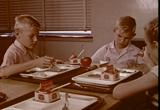
I watched some instructional films from the 1950s and '60s, the foremost being Lunchroom Manners, made famous by Paul Reubens' comedy club version of The Pee-Wee Herman Show ("Was that a big enough piece of cake or what!?"). But as I watched Phil and the other towheaded Children of the Damned beaten into submission by firm instructions peppered with the adverbs of conformity--"quietly," "politely," "neatly," "slowly," and, of course, "thoroughly"--I found my derisive laughter growing forced, as I succumbed to a flickering 1959--when I was three--in which kids who were never really all that quiet or polite or neat moved in soft fluorescence amid the featureless Alphaville of modernizing education, an All-Purpose Room of squared-off spongy linoleum along which Eames contour chairs glided like beige geese, and the furthest horizon had the quiet lines of a simple geometry problem. Watching Phil deciding not to cut in line and breaking off a piece of his cookie (rather than offering a bite), I realized I knew that kid, and that he, in part, was me. After first grade, and before seventh, I cultivated a dutiful demeanor, with a little daydreamy quietude thrown in--at least in school. To this day the thought of a classroom bathed in light while a stormy day darkens the big windowed wall makes me feel as cozy as an English cat by a glowing fender. Those were good days to be in school, as the meandering quiet of a 1962 classroom passed in lazy ovals, number-two lead spiralling across my yellow sheet with a Crucifix and "J.M.J." drawn at the top, Palmer Method penmanship class slipping with a small wink into Art--a minimal line of endless circular movement, forming a gray tunnel, almost a burrow.

The more I thought about Lunchroom Manners, the more I realized that cinema's delirious power lies in its assertive idealizations: images of blocky shoes planted firmly on the ground while nice ladies restock the milk, a world sad and beautiful, just as Roberto Benigni insisted in Down by Law (1986), narrow and soft, stern and sleepy--and gone forever. And watching the final scene--as Mr. Bungle (the puppet who couldn't use a napkin correctly if his rubber head depended on it) grew "ashamed" for being, well, a bungler--a part of me whispered, "'Gone forever,' all right, and good riddance." But the pencil-fine ovals turn, while the noses get picked, and the feet never stay firmly on the ground, and I START FILM again, just to see.